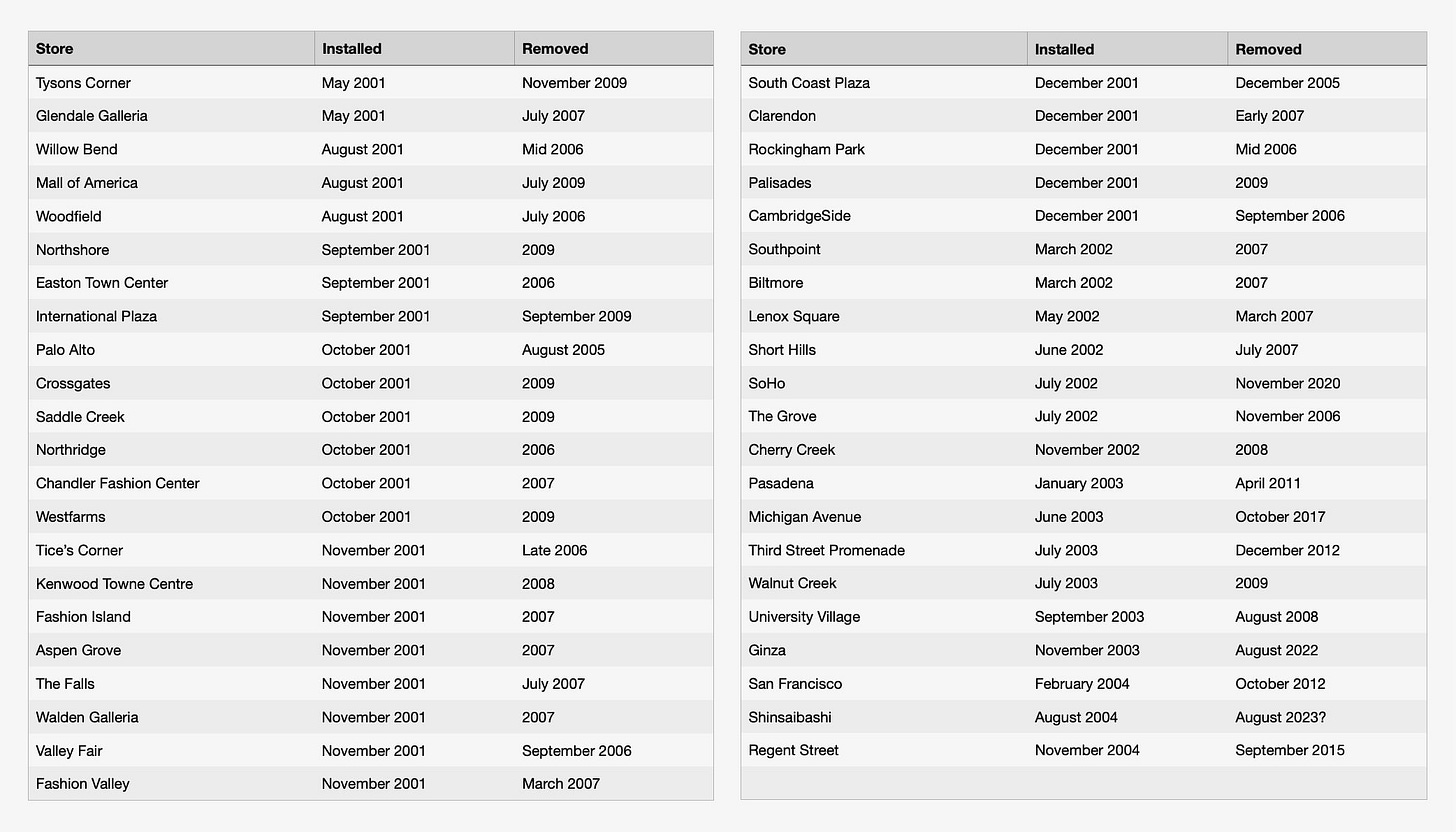The Theater
Commemorating one of the most enduring ideas in Apple Retail design.
In 1969, photographer Ivor Sharp shot a collection of photos of John Lennon and Yoko Ono’s Montreal Bed In For Peace for TIME magazine. 32 years later, Apple chose an image from that set to introduce the world to its first retail stores. The photo, which first appeared in Apple’s Think Different campaign, hung on a retractable canvas stretched across the back wall of the store. That space was home to the Theater, one of the most innovative features of the Apple Store.
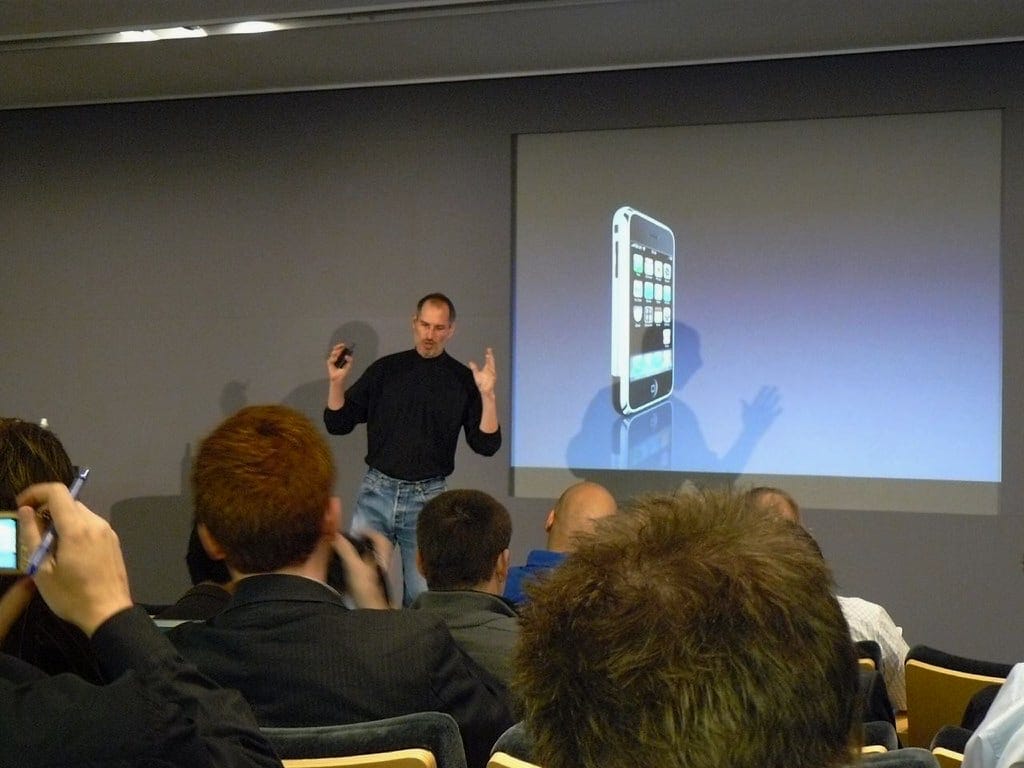
Over the next three years, Apple went on to install Theaters in 43 of its earliest stores. Education was the pillar on which Apple Retail’s success was built, and nowhere was it more visible than the Theater. These weren’t movie theaters, they were places to level up your skills, connect with others, and discover new artists. Aside from the Genius Bar, no idea continues to have a more profound lasting impact on the design of today’s Apple Stores.
That longevity makes it all the more astonishing that the Theater emerged essentially fully formed from day one. This is the earliest conceptual rendering of the first Apple Store I’ve ever managed to find online:
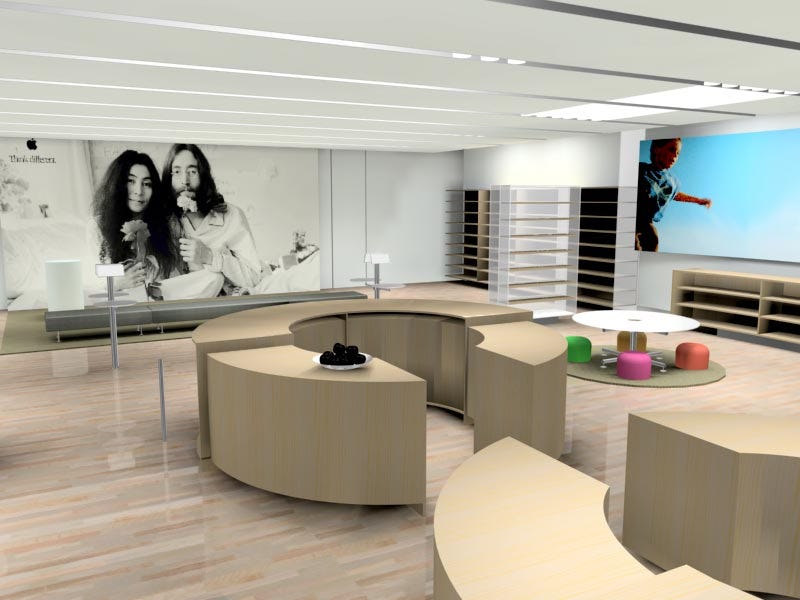
The fixtures are vague and the furniture feels unfocused, but the Theater is already present with astonishing clarity, right down to the John Lennon poster. When Apple Tysons Corner opened in May 2001, the Theater contained a few low wood benches, black carpeting, a presenter’s podium, and a projection screen. You can explore that original design with The Apple Store Time Machine. Here’s how Apple described it:
Theater—Where customers can watch demonstrations of Apple’s latest innovations, like our revolutionary new operating system, Mac OS X, on the store’s giant 10 foot diagonal screen.
The Theater screen was nothing like the video walls in today’s Apple Stores. It was comparatively dim, slightly recessed, and relatively small. Think of it more like a projection screen in a lecture hall. In a way, the Theater was a public extension of Apple’s own Town Hall at Infinite Loop. Apple executives presented in Theaters at new store openings and for special events. Keynotes like WWDC 2003 were even streamed to stores by satellite.
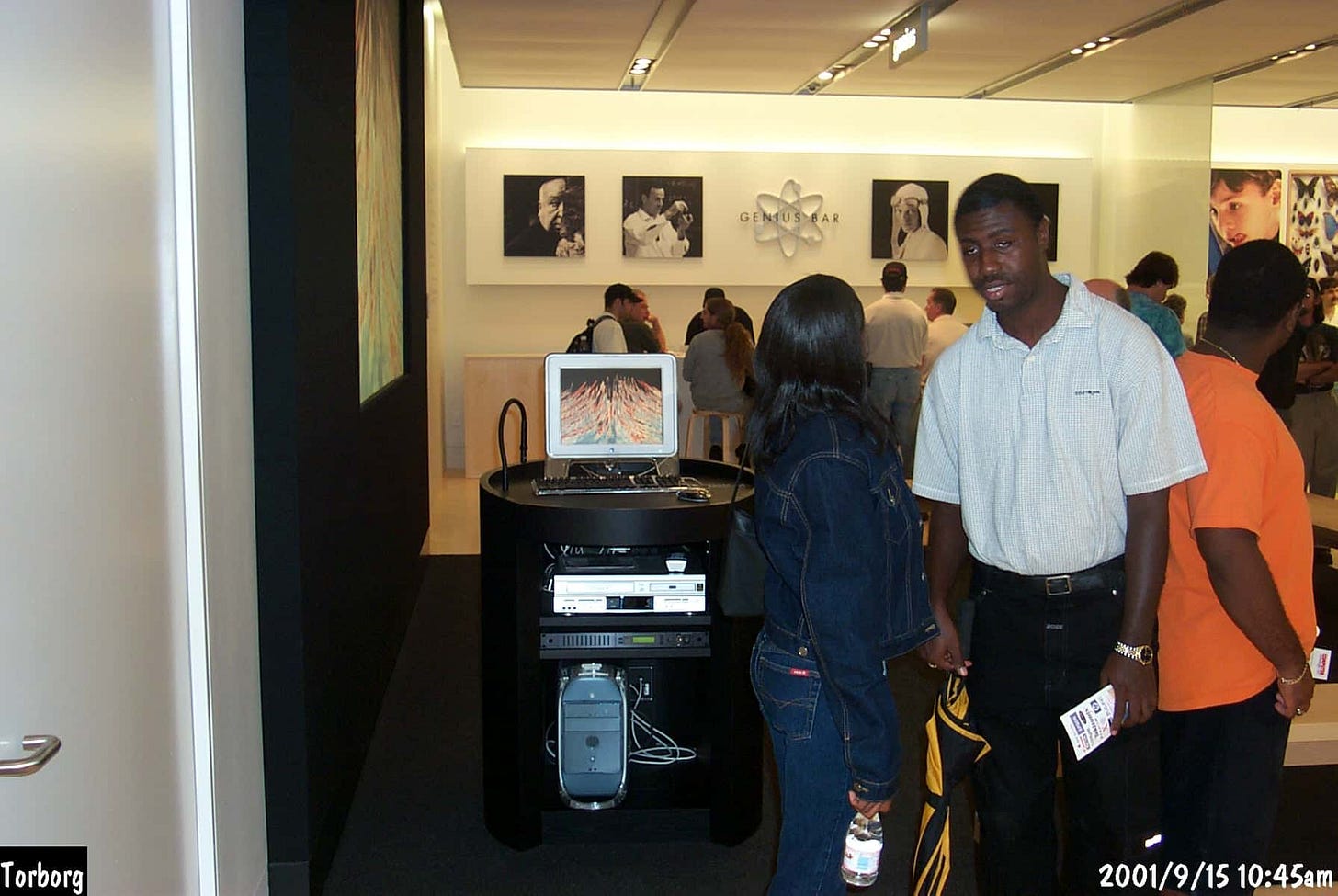
The screen was driven by a Power Mac G4, LCD Studio Display, and the five-month-old iTunes Visualizer. The podium also contained a microphone, combo VHS/DVD player, and what Google Lens has identified as the Shure U45-J4 Audio Receiver.
All 27 Apple Stores that opened in 2001 were built with nearly identical Theaters that hosted an evolving calendar of presentations like “Organizing & Distributing Your Digital Images” and “Gear Up for College.” Some events, like “Getting Started on a Mac” survive to this day. There were also eccentric titles like “Steinberg Cubase VST 5.0 - The Studio System,” “AccountEdge2—Advanced,” and the oddly intriguing “Wheel of Fortune 2nd Edition.”
In 2002, Apple revised the Theater strategy, both diminishing its role and raising its profile. Apple Roosevelt Field debuted a more compact and cost-efficient store design that sacrificed the Theater for a checkout counter, and later, the Genius Bar. The Theater was to become a feature exclusive to the largest and most prestigious stores like Apple SoHo, which opened two days before Roosevelt Field.
With the strategy change came a shift in programming towards Meet the Expert special events that invited notable creators to share their stories. In came live concerts. Stores lacking Theaters continued to offer regular Workshops wherever there was room.
Apple SoHo was the first store with a greatly expanded Theater filled with more comfortable chairs that resembled seating at a traditional theater. Apple repurposed the design of seats at its Town Hall and the Pixar Animation Studios Theater in Emeryville. In most stores the upholstery was black, but at Apple Ginza and San Francisco it was red. A few of the last Theaters settled on a hybrid design with a mall store-sized event space and rows of Eames seating.
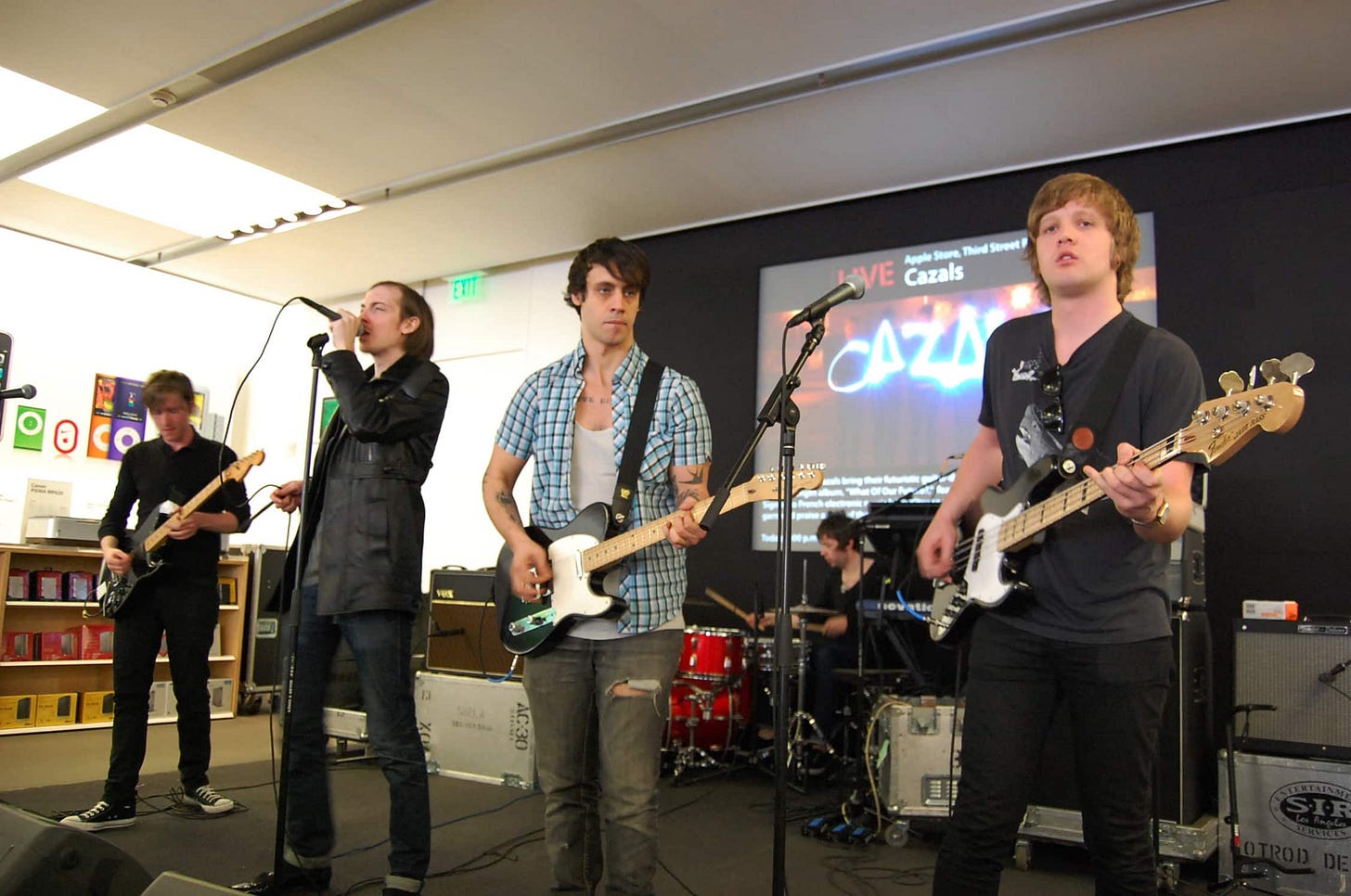
Over the next decade, the Theater became synonymous with the best of Apple Retail. In October 2003, Night of the Panther events celebrated the launch of Mac OS X 10.3 with Theater demos and giveaways. The same year, Apple offered School Night at the Apple Store, a K–12 program that allowed students and teachers to share their projects made on a Mac. A similar program called College Night was available in Japan.
Pro Day offered professionals weekly opportunities before opening time to learn how to run a business with Macs. Apple SoHo hosted events for the Tribeca Film Festival. In 2006, Apple celebrated Nike + iPod with events starting in the Theaters at Michigan Avenue, San Francisco, Third Street Promenade, and SoHo. For years, Apple offered an Events at the Apple Store podcast series filmed in Theaters. There was even a Apple Retail Store Event Dashboard widget for Mac OS X complete with a tiny illustration of those upholstered seats.
While some of the most prestigious Theaters like Regent Street and SoHo were expanded to accommodate countless events, those in malls were slowly forgotten. Idle Theater screens cycled through Apple ads and promo videos. In this photo, the vacant Theater at Apple Valley Fair is piled with an assortment of accessories. Starting in 2005, Apple began eliminating Theaters as part of a larger remodeling strategy that reconfigured the store layout. By the end of 2009, all but a handful were gone.

In 2015, Apple reinvested in retail education by launching the Forum, and later, Today at Apple. Three of the last five Theater stores — Michigan Avenue, Regent Street, and SoHo were remodeled or replaced with new spaces featuring grand Forums. In August 2022, Apple Ginza moved to a temporary store and the original building was demolished. Suddenly, there was just one Theater left: Apple Shinsaibashi. And on August 22, news came of renovations in Osaka that have closed the entire Theater level of the store.
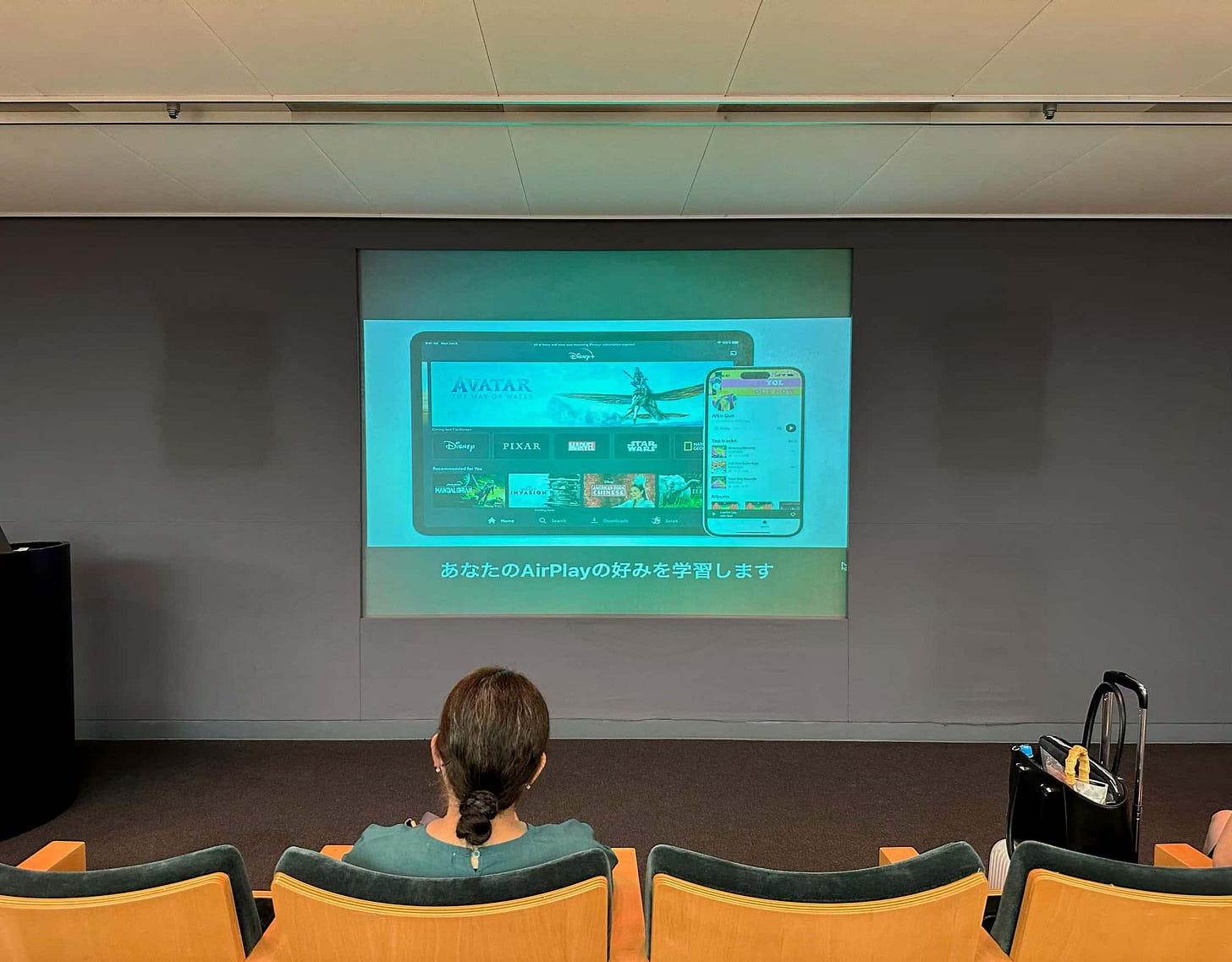
If all of this sounds familiar to you, there’s a reason why. The ascent, flourishing, and slow dissolution of the Theater mirrors the trajectory of the Forum to an uncanny degree. Take a look at the timeline:
2001: Apple introduces the Theater and begins installing one in every store.
2002: World-class stores add larger Theaters to host special guests.
2002: Apple debuts a cost-efficient store design that eliminates the Theater.
2003: Theaters become exclusive to the most significant new stores.
2005: Apple begins replacing Theaters with expanded Genius Bars.
2015: Apple introduces the Forum and begins installing one in every store.
2016: World-class stores add larger Forums to host special guests.
2021: Apple debuts a cost-efficient store design that eliminates the Forum.
2022: Forums become exclusive to the most significant new stores.
2023: Apple begins replacing Forums with pickup and service areas.
History has a way of repeating itself, and good ideas never truly die — they just go out of fashion.
If you’d like to suggest a topic for me to research for next month’s bonus article or have a story to share, send me an email. You can view this post and the entire Tabletops archive on the web at any time here.

